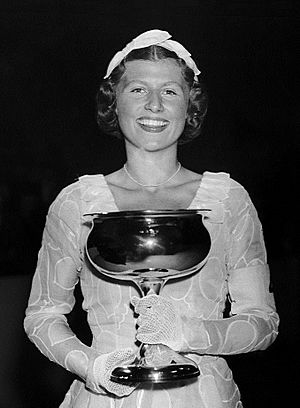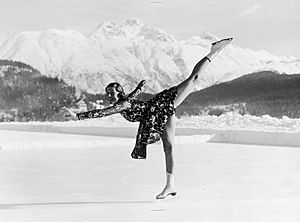Cecilia Colledge facts for kids
Quick facts for kids Cecilia Colledge |
|||||||||||||||||||||||||||||||||||||||||||||||
|---|---|---|---|---|---|---|---|---|---|---|---|---|---|---|---|---|---|---|---|---|---|---|---|---|---|---|---|---|---|---|---|---|---|---|---|---|---|---|---|---|---|---|---|---|---|---|---|

Cecilia Colledge in 1937
|
|||||||||||||||||||||||||||||||||||||||||||||||
| Personal information | |||||||||||||||||||||||||||||||||||||||||||||||
| Full name | Magdalena Cecilia Colledge | ||||||||||||||||||||||||||||||||||||||||||||||
| Country represented | United Kingdom | ||||||||||||||||||||||||||||||||||||||||||||||
| Born | 28 November 1920 London, England, United Kingdom |
||||||||||||||||||||||||||||||||||||||||||||||
| Died | 12 April 2008 (aged 87) Cambridge, Massachusetts, United States |
||||||||||||||||||||||||||||||||||||||||||||||
| Height | 152 cm | ||||||||||||||||||||||||||||||||||||||||||||||
| Former coach | Jacques Gerschwiler Eva Keats |
||||||||||||||||||||||||||||||||||||||||||||||
| Skating club | Queens Park Ice Rink | ||||||||||||||||||||||||||||||||||||||||||||||
| Retired | 1946 | ||||||||||||||||||||||||||||||||||||||||||||||
|
Medal record
|
|||||||||||||||||||||||||||||||||||||||||||||||
Magdalena Cecilia Colledge (born November 28, 1920 – died April 12, 2008) was an amazing British figure skater. She won a silver medal at the 1936 Winter Olympics. She was also a World Champion in 1937.
Cecilia was a three-time European Champion (1937–1939). She also won the British national title six times. She was the first female skater to do a double jump. She also invented the camel spin and the layback spin.
Contents
About Cecilia Colledge
Cecilia Colledge grew up in London, England. Her father, Lionel, was a surgeon. Her mother, Margaret, was the daughter of an admiral.
Cecilia had a brother named Maule. He served in the Royal Air Force. Sadly, he died during World War II. Cecilia never married and did not have children. She passed away in 2008 in the United States.
Cecilia's Skating Journey
Cecilia started skating after watching the 1928 World Championships. These were held in London. She was inspired by the performances of Sonja Henie and Maribel Vinson. They won gold and silver medals.
Her coaches were Eva Keats and Jacques Gerschwiler. At just eleven years old, Cecilia competed in the 1932 Winter Olympics. She was the youngest Olympic figure skater ever at that time. She finished in 8th place.
Early Successes
Cecilia won a silver medal at the 1933 European Figure Skating Championships. In 1935, she won her first British national title. That same year, she earned a bronze medal at the 1935 European Figure Skating Championships. She also won a silver medal at the 1935 World Figure Skating Championships.
The 1936 Olympics
In 1936, Cecilia won her second national title. She also got her second European silver medal. At the 1936 European Figure Skating Championships, she made history. She landed a double salchow jump. This made her the first woman to do a double jump in a competition!
At fifteen, she competed in the 1936 Winter Olympics. She won the silver medal. She was very close to Sonja Henie, who won gold. After the first part of the competition, Cecilia was only a few points behind Henie.
There was some discussion about the free skating draw. Henie got to skate last. Cecilia had to perform second out of 26 skaters. Skating early was seen as a disadvantage. The audience might not be as excited yet. Judges were also known to give higher scores later in the event. Years later, rules changed to make the draw fairer.
World and European Champion
In 1937, Cecilia won two British Championships. She also won her first European title. This was at the 1937 European Figure Skating Championships. She then became a World Champion at the 1937 World Championships.
The next year, she won her fifth national title. She also earned her second European title. She won a silver medal at the 1938 World Figure Skating Championships. A skating expert, T.D. Richardson, wrote about her. He said her free skating was the most difficult. She made hard jumps and spins look easy.
In 1939, she won her third European title. However, she could not compete at the 1939 World Championships. She had a strained achilles tendon.
After the War
During World War II, there were no skating competitions. Cecilia helped by driving an ambulance during the London Blitz. After the war, she returned to skating. She won her sixth and final British national title. She then became a professional skater. She won the Open Professional Championship in 1947 and 1948.
In 1951, Cecilia moved to the United States. She became a skating coach in Boston. She coached at the Skating Club of Boston for many years. Some of her students became famous skaters.
Cecilia Colledge was honored in 1980. She was inducted into the World Figure Skating Hall of Fame.
Skating Innovations
Cecilia Colledge was a true pioneer in figure skating. She introduced several new moves.
- First Double Jump: At the 1936 European Championships, she landed a double salchow. This was the first time a female skater completed a two-rotation jump in competition.
- Spin Inventions: She is known for inventing the camel spin. She also created its special "catchfoot" version. She also invented the layback spin.
- Biellmann Spin Transition: She was one of the first skaters to move from a layback spin into a one-hand Biellmann spin.
- The "Colledge" Jump: She also invented a jump called the "one-foot Axel jump." It is also known as the Colledge jump, named after her!
Competitive Highlights
| International Competitions | |||||||||
|---|---|---|---|---|---|---|---|---|---|
| Event | 1932 | 1933 | 1934 | 1935 | 1936 | 1937 | 1938 | 1939 | 1946 |
| Winter Olympics | 8th | 2nd | |||||||
| World Championships | 8th | 5th | 2nd | 1st | 2nd | ||||
| European Championships | 2nd | 3rd | 2nd | 1st | 1st | 1st | |||
| National Competitions | |||||||||
| British Championships | 2nd | 2nd | 2nd | 1st | 1st | 1st | 1st | 1st | 1st |



